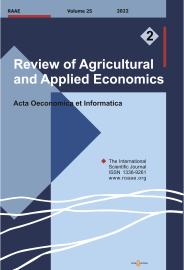KEYWORDS:
Balassa, comparative advantage, growth, export, stability
DOI NUMBER:
10.15414/raae.2017.20.01.31-38
ABSTRACT:
Trade in agricultural commodity has significantly played a vital role in world’s economic growth and development. Drawing its strength from the agricultural industry, such important roles include contribution to quality food production, job creation, foreign exchange earnings, and industrial inputs. The objective of the article was to examine trade competitiveness and revealed comparative advantages of global tropical fruits and to measure the stability and duration of Balassa indices by applying Kaplan-Meier survival function and Markov transition probability matrices. Results reveal that Spain, Ecuador, and The United States were the main exporters of the examined tropical fruits in the periods evaluated, together giving 29% of all products exported. The top10 countries, therefore, consisted 60% of concentration, dominated by fresh or dried banana, including plantains, which constitutes more than 25% of trade, followed by fresh apples which represents more 18% of the total tropical fruits trade for all the periods. The Balassa indices, however, were the highest for Costa Rica and Ecuador. Typically, comparative advantages seem to diminish for most of the countries as manifested by the stability tests and mobility indices.
Please Cite this Article as:
Alieu GIBBA (2017) Trade Competitiveness In Global Tropical Fruits. Review of Agricultural and Applied Economics. XX (Number 1, 2017): 31-38. doi: 10.15414/raae.2017.20.01.31-38
URL for sharing:
https://roaae.org/1336-9261/doi/abs/10.15414/raae.2017.20.01.31-38
FULL TEXT PDF:
▼ direct download link| view online in fullscreen ▲

